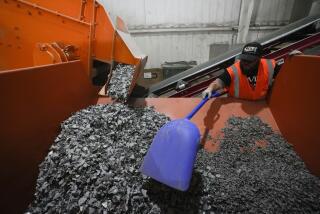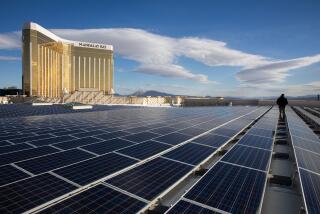Getting a Charge Out of Solar
- Share via
S olar has become an energy buzzword today among environmentalists seeking non-polluting, renewable alternatives to fossil fuels. But what precisely is it?
Even people who sing the praises of solar aren’t always sure, says John Schaeffer, president of Real Goods Trading Corp. in Ukiah, Calif., which has been selling mail-order solar equipment for more than a decade.
First of all, he says, solar power has a new look.
“There are misconceptions,” he says. “Lots of people remember the solar hot water panels that were marketed by snake-oil salesmen going door-to-door in the late ‘70s with a lot of promises about dollar savings and tax credits. It left a bad taste, the way the whole thing was marketed.”
Today’s solar panels, called PV modules, convert sunlight to electricity.
Its basic unit is a photovoltaic (or PV) cell, explains Schaeffer. “Solar manufacturers grow silicon crystals in a lab and slice them into wafers, like computer chips, and add boron and phosphorous, which attract opposite charges, converting sunlight to an electric current.
“They typically put a bunch of these on a glass panel and hook them up together, making one large photovoltaic module, which becomes the building block to a solar system. There’s a junction box on the back where you hook electrical wires.”
The module can produce electricity directly, or store it in batteries for later use. An inverter can convert the direct current to alternating current for household use. “You can feed it into your breaker box. Obviously you have to get code approval, but people do it all the time,” Schaeffer says.
Once limited to rural use, solar panels are increasingly finding their way to town as environmentalists like Ted Baumgart discover their non-polluting virtues. Home kits vary in price from $1,000 to $10,000.
“We’ve started getting orders from the urban homeowner in the last couple of years,” says Schaeffer. “We’re finding a big application for solar pool cleaners. We have a device which produces ions, which clean the pool and eliminate the need for chlorine which smells bad, tastes bad and is toxic.
“Solar is also good for sidewalk and garden lights, where you don’t want to run wires or dig a trench. They charge up a battery during the day and run the lights at night. And there are other uses, like solar vents you put on the ceiling to suck out the hot, stale air.”
He expects orders to keep increasing: “Given the fact that grid-powered energy is increasing by 10% a year, we think solar will be competitive by the year 1997.”
More to Read
Inside the business of entertainment
The Wide Shot brings you news, analysis and insights on everything from streaming wars to production — and what it all means for the future.
You may occasionally receive promotional content from the Los Angeles Times.










